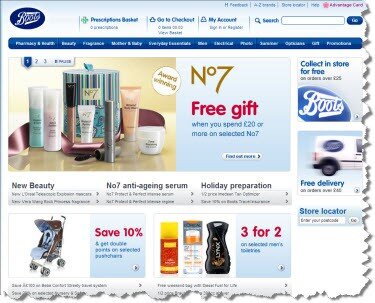Newspaper readers are often enticed by advertising offers which give them savings – “half price”, “two for one” and so on. Many advertisers now add their web site details to the advert. But they may as well not bother.

Take adverts in yesterday’s “The Times”. Tesco was advertising “Joint Savings” – half price leg of pork which it said was available at it’s web site, tesco.com. So, what happens when you go to the link? Well, you firstly have to decide which section of the shop you want. Then you have to log in. After that you have to choose which department you want and then you have to scroll down to find the offer. It takes a minimum of four clicks and about one minute to get to the offer, which is right down the bottom of the long listing. Most people will give up.
So, if Britain’s “Number One” retailer is failing in the offline/online mix, what about another High Street stalwart, Boots? In yesterday’s newspapers they were advertising their “Buy 1, get 1 free” offer on hay fever tablets. Get the offer from Boots.com, said the newspaper advert. So what happens when you visit the web site? Well, unless you have a massive screen – nothing. The offer is actually hidden away right at the bottom of the page. You have to scroll down to find it. Unless people see it straight away, they could well give up.
What about Harrods then? They must be doing something right. No. Their newspaper advert yesterday was signalling “Up to 50% off” furniture and homewares. What do you see when you get to their web site? “10% off your order in May” and “Free delivery on all orders over £50”. Their newspaper advert even proudly announces that the sale preview starts on 30th May. Luckily the web site has a calendar – under which there is no entry for that date. I gave up looking for the cheap furniture.
Over at Expedia, though, things are different. The newspaper advert announces “One Million Free Nights” and when you go to the web site, that’s exactly what hits you between the eyes, slap bang in the top of the page. You would, of course, expect Expedia to do this; after all the company was originally a department within Microsoft designed to arrange executive travel. This company was born online and therefore only really knows about the online world.
The likes of Tesco, Boots and Harrods are showing how little they still understand the online world. Expecting people to look at your advert and then search for the item is “old world” thinking. That’s what people do in bricks and mortar stores. They see an advert, visit the store and have a look around hoping to find the offer. Meanwhile, of course, the retailer hopes they’ll also see other things that attract their attention and buy even more items.
Online, however, people shop differently. They visit stores for a specific purchase. So if they see an advert for pork or hay fever tablets they expect the link to take them directly to that item. There are two ways of achieving this. One is to ensure that your web site’s home page matches the offline advertising directly. Hence the Boots.com site should have had the hay fever tablets in prime position at the top of the page, not hidden away at the bottom.
A second method, though, is much more effective. This is to have a specific domain name for each advertised item. For instance, Tesco is advertising it’s half price pork offer, so their newspaper advert could have had a link to “tescopork.com” instead of to the generic web site. At “tescopork.com” the visitor sees the offline offer repeated, together with the ability to buy it right now. Job done – one click, no searching, no scrolling, no fuss.
Most traditional retailers have still to work out how to mix offline and online marketing in a truly effective way. Few do it well, even though it is very easy. So, if your business has products and services that you advertise or market offline, make sure you have easy to remember domain names that take people directly to what they want.
When you mix offline promotions with your online world, using specific domain names (even if they point to pages within an existing web site) is far more effective than just giving your main “home page” address. Tesco, Boots and Harrods all need to learn this lesson – and in doing so could make even more money from their special offers. But I guess as they are already getting millions they aren’t that bothered..!

